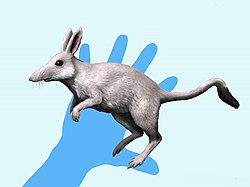Description
Distinctive characteristics (synapomorphies) of Metatheria include a prehensile tail, the development of a capitular tail on the humerus, the loss of tooth replacement on the second and fifth premolars, lower canines that outwardly diverge from each other, an angular process on the dentary bone—which additionally bears a posterior shelf in its masseteric fossa in Metatheria [4] —that is equal to or greater than the length of the ramus, [4] [5] : Appendix 2 and the lower fifth premolar with a "very trenchant" [4] cristid obliqua/ectolophid. The permanent, retained deciduous fifth premolars are molar like and were historically identified as first molars, with the third premolar found in basal therians being lost, leaving four premolars in the halves of each jaw. [4] Sinodelphys differs in its dentition and may represent a basal metatherian. [4]
Evolutionary history
The relationships between the three extant divisions of mammals (monotremes, marsupials, and placentals) was long a matter of debate among taxonomists. [6] Most morphological evidence comparing traits, such as the number and arrangement of teeth and the structure of the reproductive and waste elimination systems, favors a closer evolutionary relationship between marsupials and placental mammals than either has with the monotremes, as does most genetic and molecular evidence. [7]
The earliest possible known metatherian is Sinodelphys szalayi , which lived in China during the Early Cretaceous around 125 million years ago (mya). [4] [8] This makes it a contemporary to some early eutherian species that have been found in the same area. [9] However, Bi et al. (2018) reinterpreted Sinodelphys as an early member of Eutheria. The oldest uncontested metatherians are now 110 million year old fossils from western North America. [3] Metatherians were widespread in Asia and North America during the Late Cretaceous, including both Deltatheroida and Marsupialiformes, [10] with fossils also known from Europe during this time. During the Late Cretaceous, metatherians were more diverse than eutherians in North America. [4] Metatherians underwent a severe decline during the Cretaceous–Paleogene extinction event, more severe than that suffered by contemporary eutherians and multituberculates, and were slower to recover diversity. [10]
Morphological and species diversity of metatherians in Laurasia remained low in comparison to eutherians throughout the Cenozoic. [11] The two major groups of Cenozoic Laurasian metatherians, the opossum-like herpetotheriids and peradectids persisted into the Miocene before becoming extinct, with the North American herpetotheriid Herpetotherium , the European herpetotheriid Amphiperatherium and the peradectids Siamoperadectes and Sinoperadectes from Asia being the youngest Laurasian non-marsupial metatherians (with marsupials invading North America during the Pliocene-Pleistocene as part of the Great American interchange). [12] [10] Metatherians first arrived in Afro-Arabia during the Paleogene, probably from Europe, including the possible peradectoid Kasserinotherium from the Early Eocene of Tunisia and the herpetotheriid Peratherium africanum from the Early Oligocene of Egypt and Oman. The youngest African metatherian is the possible herpetotheriid Morotodon from the late Early Miocene of Uganda. [13] [14]
Metatherians arrived in South America from North America during the latest Cretaceous or Paleocene and underwent a major diversificiation, with South American metatherians including both the ancestors of extant marsupials as well as the extinct Sparassodonta, which were major predators in South American ecosystems during most of the Cenozoic, up until their extinction in the Pliocene, as well as the Polydolopimorphia, which likely had a wide range of diets. [11] Metatherians then declined in diversity in South America during the Late Eocene as well as the later Oligocene epoch. The oldest known Australian marsupials are from the early Eocene, and are thought to have arrived in the region after having dispersed via Antarctica from South America. [11] During the Oligocene epoch, Australian metatherians radiated rapidly, which contributed most to the global peak in metatherian diversity during the Early Miocene. The only known Antarctic metatherians are from the Early Eocene La Meseta Formation of the Antarctic Peninsula, where they are the most diverse group of mammals, and include marsupials as well as polydolopimorphians. [11]
This page is based on this
Wikipedia article Text is available under the
CC BY-SA 4.0 license; additional terms may apply.
Images, videos and audio are available under their respective licenses.






